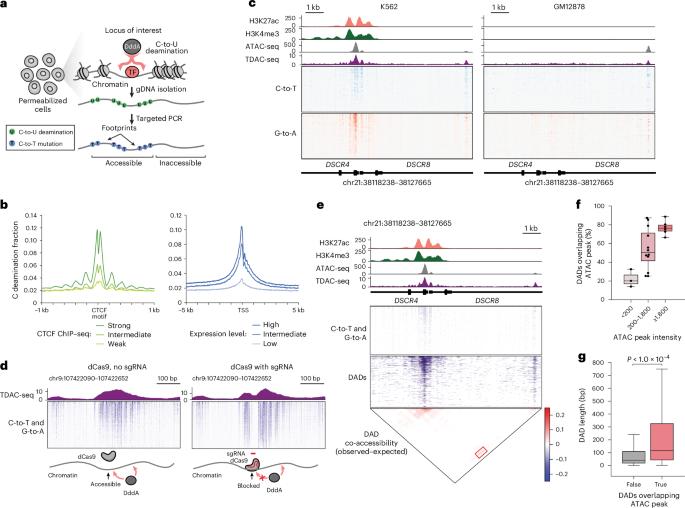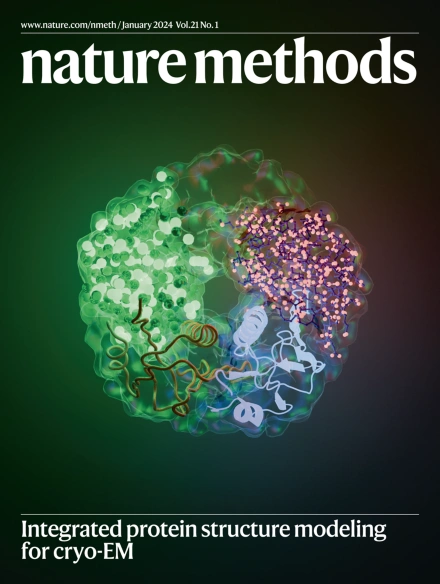使用双链DNA脱氨酶耦合CRISPR扫描与靶向染色质可及性分析。
IF 32.1
1区 生物学
Q1 BIOCHEMICAL RESEARCH METHODS
引用次数: 0
摘要
基因组编辑使内源性顺式调控元件的序列功能分析成为可能,从而推动对其机制的理解。然而,这些方法缺乏直接的、可扩展的跨长单分子染色质纤维的染色质可及性读数。在这里,我们利用双链DNA胞苷脱氨酶,通过靶向PCR和长读测序来分析内源性感兴趣位点的染色质可达性,我们称之为靶向脱氨酶可达性染色质测序(TDAC-seq)。TDAC-seq在目标位点上具有高序列覆盖率,可以与CRISPR扰动结合,以单核苷酸分辨率将基因编辑及其对同一单个染色质纤维上染色质可及性的影响联系起来。我们使用TDAC-seq分析了在红系分化过程中激活人CD34+造血干细胞和祖细胞(HSPCs)中胎儿血红蛋白的CRISPR编辑,以及在混合CRISPR和碱基编辑筛选中覆盖控制珠蛋白位点的增强子。我们进一步扩展了该方法,在CD34+ HSPCs的单个合并CRISPR实验中询问与骨髓增生性肿瘤风险相关的gfi1b连接增强子中的947个变体。总之,TDAC-seq通过基因组编辑实现了单分子染色质纤维的高分辨率序列功能定位。本文章由计算机程序翻译,如有差异,请以英文原文为准。

Coupling CRISPR scanning with targeted chromatin accessibility profiling using a double-stranded DNA deaminase
Genome editing enables sequence-function profiling of endogenous cis-regulatory elements, driving understanding of their mechanisms. However, these approaches lack direct, scalable readouts of chromatin accessibility across long single-molecule chromatin fibers. Here we leverage double-stranded DNA cytidine deaminases to profile chromatin accessibility at endogenous loci of interest through targeted PCR and long-read sequencing, a method we term targeted deaminase-accessible chromatin sequencing (TDAC-seq). With high sequence coverage at targeted loci, TDAC-seq can be integrated with CRISPR perturbations to link genetic edits and their effects on chromatin accessibility on the same single chromatin fiber at single-nucleotide resolution. We employed TDAC-seq to parse CRISPR edits that activate fetal hemoglobin in human CD34+ hematopoietic stem and progenitor cells (HSPCs) during erythroid differentiation as well as in pooled CRISPR and base-editing screens tiling an enhancer controlling the globin locus. We further scaled the method to interrogate 947 variants in a GFI1B-linked enhancer associated with myeloproliferative neoplasm risk in a single pooled CRISPR experiment in CD34+ HSPCs. Together, TDAC-seq enables high-resolution sequence-function mapping of single-molecule chromatin fibers by genome editing. This paper presents TDAC-seq, a targeted chromatin-accessibility-profiling method using cytidine deaminases and long-read sequencing, to resolve the effects of CRISPR edits on single chromatin fibers.
求助全文
通过发布文献求助,成功后即可免费获取论文全文。
去求助
来源期刊

Nature Methods
生物-生化研究方法
CiteScore
58.70
自引率
1.70%
发文量
326
审稿时长
1 months
期刊介绍:
Nature Methods is a monthly journal that focuses on publishing innovative methods and substantial enhancements to fundamental life sciences research techniques. Geared towards a diverse, interdisciplinary readership of researchers in academia and industry engaged in laboratory work, the journal offers new tools for research and emphasizes the immediate practical significance of the featured work. It publishes primary research papers and reviews recent technical and methodological advancements, with a particular interest in primary methods papers relevant to the biological and biomedical sciences. This includes methods rooted in chemistry with practical applications for studying biological problems.
 求助内容:
求助内容: 应助结果提醒方式:
应助结果提醒方式:


